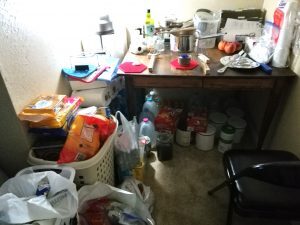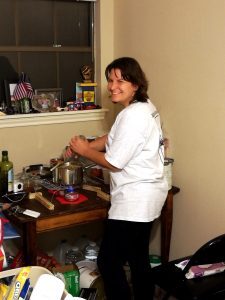
Rescue boats fill a flooded street as flood victims are evacuated as floodwaters from Tropical Storm Harvey rise in Houston on Aug. 28. BYU alumna Kate Fults said her family was stranded for three days when the hurricane hit Houston, but was totally fine due to their emergency preparation beforehand. (AP Photo/David J. Phillip)
Rusty Kappel has lived through his share of natural disasters.
Hurricane Agnes in Virginia in 1972 left his family without power for just under two weeks. An ice storm left his family without power for one week. And sub-20 degree weather once shut down everything in his city for five days due to freezing temperatures.
Looking back on his life, Kappel said it made sense for him to go into the emergency preparedness business. He now owns the Preparedness Store and Bosch Kitchen Center in Idaho Falls, Idaho.
Devastating hurricanes Harvey, Irma and Maria as well as wildfires in northern and southern California demonstrated the need for emergency preparedness, in particular, 72-hour-kits.
Why 72-hour kits?
The two leading states when it comes to emergency preparedness in the U.S. are Utah and Idaho, according to Kappel. However, Kappel added there is 'definitely a general demand' for emergency preparedness everywhere.

BYU alumna Kate Fults made sure she had everything her family would need during Hurricane Harvey in Aug. 2017. Fults and her family spent three days stranded in the upstairs of their house in Houston. (Kate Fults)
Kappel said each emergency kit should contain different items specific to the kinds of emergencies someone would face in the area they live in. While everybody should at least start with a 72-hour kit, Kappel said people should be prepared for emergency situations with one to two weeks' worth of supplies, food and water.
Kappel said the term '72-hour kit' was created by the Church of Jesus Christ of Latter-day Saints in conjunction with the Red Cross, because 72 hours is how long it would take the Red Cross to 'get emergency supplies and manpower to come into an area and meet a need.' However, past natural disasters have shown it can take even longer, Kappel said.
Kappel said the cost of emergency kits vary. His store has three different 72-hour kits: one for $55, one for $140 and one for $240. However, Kappel said he has seen 72-hour kits for as much as $1,000 and for as little as $20.
“I try to tell people not to kid themselves. Are you buying a kit to just satisfy your mind, or are you buying a kit that would really save your life? There is a difference,' Kappel said. 'There’s a bunch of junk that I see out there and put in kits that there’s no way in a real emergency that it would keep you alive. And yet, I’ve seen other kits where I say, 'Woah, that’s a little bit overboard.''
Former BYU student Mary Crance from Margate, Florida, volunteered with the Red Cross for 20 years by helping to educate the community about disaster preparedness. She is no stranger to the need to be prepared herself.
Crance lived in Florida in 1992 when category 5 Hurricane Andrew hit. She said she and her family had to 'take (their) stuff and go.' Although Crance wasn't as prepared for emergencies then as she is now, she said the things she did have prepared were enough to help them survive.
“Emergencies don’t come knocking on your door saying, 'Hi, I’m here. Can I come back in about three days so you can be ready for me?'' Crance said. 'If you’re not ready for these things, then at a minimum you’re going to be highly inconvenienced. At worst, you may lose your house; you may lose your life.”
Importance of disaster preparedness
Now, Crance said she is more prepared for emergencies than she used to be. She said she and her family 'could get everybody in the vehicles and (could) get everything (they) needed for a minimum of a week in those vehicles and be gone in 20 minutes if (they) had to.'
BYU alumna Kate Fults lives in Houston, Texas. She, her husband and their three children were stranded in the upstairs of their flooded home from Aug. 27 to Aug. 30 after Hurricane Harvey hit. It was the first time Fults' neighborhood had been flooded in 40 years.
Fults said she had her family's 72-hour kits and their get-up-and-go bags packed and ready to go.

From left: Millie Fults, Frank Fults V and Jane Fults spent three days stranded in the upstairs of the home during Hurricane Harvey. Their mother, Kate Fults, said the time was enjoyable as a family because she was prepared. (Kate Fults)
That helped keep her children from being scared.
Fults said she tries to have at least three months supply of food storage on hand and one month's worth of emergency supplies in her home at all times.
In preparing for Hurricane Harvey, Fults said there were many people frantically preparing for the looming natural disaster.
“You (went) in the stores and they (were) just bare,' Fults said. 'I was so grateful that I had not waited until the last minute to be prepared.”
When facing an emergency, Fults said having a plan keeps fear at bay by providing peace and comfort. She said it can still be intense, 'but it's not near as scary.'

Kate Fults prepares a meal using a sterno can after Hurricane Harvey flooded her Texas home in August 2017. Fults said she was grateful she didn't wait to prepare for emergencies. (Kate Fults)
“You never actually think something like this is going to happen to you, you just think, 'well it’s good to be prepared. I’m following the prophet; there are blessings and comfort in that,'' Fults said. 'But then when you face it for real, there are not only blessings and comfort, there (is) safety and peace,” Fults said.
LDS Church prepares for disasters
BYU alumnus David Lauck — Fults' LDS stake president in Texas — said the stake has an emergency preparedness plan and holds an annual preparedness fair where first responders, the Red Cross and others talk about emergency preparedness.
Lauck said the stake has church members who are licensed and trained to work HAM radios that 'allow you to communicate off of shortwave towers where you wouldn’t normally be able to talk on a phone line.”
In addition, a member of the high council is assigned to emergency preparedness and members of the stake and wards are put into emergency response groups, according to Lauck.
'We’re all tied together and you really feel it during a crisis,” Fults said. “There’s something special about how our network in the church really does feel like a family. We really do look out for each other.”
Lauck said his local community in Texas was very aware of the impact the LDS Church had on relief efforts during Hurricane Harvey.
“When the hurricane hit, a lot of people were scrambling in the first two or three days,' Lauck said. 'As a matter of fact, the Red Cross, FEMA, a lot of other people were trying to get stations set up. (On) day one when the flooding occurred, we had already set up a command center at our stake center and as a part of that we were able to start meeting, assessing and going out and doing rescue visits.”
Lauck said there were over 80 boats at the stake center that could immediately go out and rescue members of the church. Once the members' needs were assessed and met, Lauck said they were out rescuing others.
Lauck said the Red Cross and their local police reached out to members and leaders of the church in the area asking for their help in setting up relief efforts.

Frank Fults V and Jane Fults stand outside their home in Houston, Texas, after Hurricane Harvey. The Fults family was prepared for the hurricane and said they spent a 'pleasant' time stranded together in the upstairs of their home for three days. (Kate Fults)
'They were amazed at how (members of) the church (were) able to so quickly organize themselves,” Lauck said.
Personal emergency preparedness
Preparing for an emergency can include preparing for a natural disaster or for a personal emergency, according to Fults. The type of preparation it calls for might just be a little different.
'I had a year where I had five surgeries, and I was so grateful I had food storage stocked up because I didn’t have it in me to be able to go out and get the food. I didn’t have the strength or the energy,” Fults said. “There’s all kinds of different preparations for different circumstances that you need throughout your life.”
It's being ready for the big things that help you be ready for the smaller things, according to Crance.
'I have things in the house for the little things ... somebody cuts themselves very badly, I’m ready to go for that. I can bandage them up pretty good before I get them to the hospital for stitches,” Crance said.
Starting an emergency preparedness kit
Preparedness starts by understanding an area's natural disasters and then figuring out what would be needed for two weeks if stranded outdoors and what would be needed if stranded inside, but it takes looking ahead, according to Crance.
Crance said to start with preparing a 72-hour kit and then build to a week, then two weeks. Once emergency kits are made, Crance said the next step is to look at the long-term preparedness through food storage. She suggested starting with one month of food and water, then building up to two months and up to a year.
Crance suggested doing a family home evening activity to talk about emergency preparedness followed by a scavenger hunt to see what items are already accounted for. Families could then finish the activity by making a list of the remaining items needed for purchase.
“Always in the back of my mind, I’m thinking 'what can I do to improve? What can I improve over last year?' It’s almost like what governments and other organizations (ask) after a disaster — 'what did I do wrong' and 'what could I do better?'” Crance said.